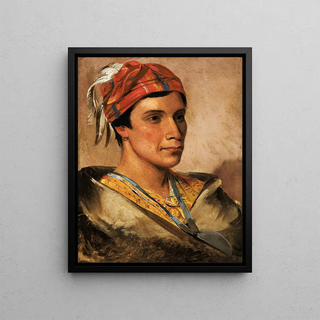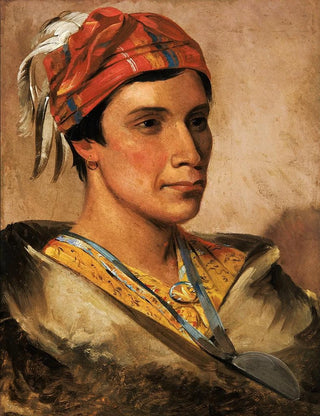Painting Chief of the Tribe's Bread - George Catlin | Art print


View from behind

Frame (optional)
The artwork "Chief of the Tribe's Bread" by George Catlin is much more than a simple painting; it is an open window into a fascinating world, that of North American indigenous peoples. Catlin, as an artist and ethnographer, dedicated his life to immortalizing the cultures and traditions of Native tribes, seeking to preserve their memory at a time when they were threatened by colonial expansion. This vibrant and detail-rich work transports us to the heart of these communities' lives and beliefs, while inviting us to reflect on the importance of cultural diversity.
Style and uniqueness of the work
Catlin's style is characterized by a blend of realism and romanticism. In "Chief of the Tribe's Bread," the vivid colors and precise details capture not only the physical appearance of the chief but also his essence and character. The artist uses earth tones and warm hues to evoke the authenticity of his subject, while the often minimalist background highlights the central figure. This stylistic choice creates an intimacy between the viewer and the subject, allowing for a deep emotional connection. Every detail, from traditional ornaments to facial expressions, tells a story, evoking the dignity and wisdom of the depicted peoples. Through this work, Catlin does not merely portray an individual; he pays homage to a rich and complex culture, while emphasizing its fragility in the face of historical upheavals.
The artist and his influence
George Catlin, born in 1796, is often regarded as one of the pioneers of ethnographic painting. His passion for Native American cultures led him to travel across the United States, where he met and documented various tribes, each with its own traditions and beliefs. Catlin skillfully combined his artistic talent with a mission of cultural preservation, aiming to raise public awareness of the challenges faced by these peoples. His work has had a lasting impact on how indigenous cultures are perceived and represented in art. By highlighting the beauty and complexity of Native societies, Catlin

Matte finish

View from behind

Frame (optional)
The artwork "Chief of the Tribe's Bread" by George Catlin is much more than a simple painting; it is an open window into a fascinating world, that of North American indigenous peoples. Catlin, as an artist and ethnographer, dedicated his life to immortalizing the cultures and traditions of Native tribes, seeking to preserve their memory at a time when they were threatened by colonial expansion. This vibrant and detail-rich work transports us to the heart of these communities' lives and beliefs, while inviting us to reflect on the importance of cultural diversity.
Style and uniqueness of the work
Catlin's style is characterized by a blend of realism and romanticism. In "Chief of the Tribe's Bread," the vivid colors and precise details capture not only the physical appearance of the chief but also his essence and character. The artist uses earth tones and warm hues to evoke the authenticity of his subject, while the often minimalist background highlights the central figure. This stylistic choice creates an intimacy between the viewer and the subject, allowing for a deep emotional connection. Every detail, from traditional ornaments to facial expressions, tells a story, evoking the dignity and wisdom of the depicted peoples. Through this work, Catlin does not merely portray an individual; he pays homage to a rich and complex culture, while emphasizing its fragility in the face of historical upheavals.
The artist and his influence
George Catlin, born in 1796, is often regarded as one of the pioneers of ethnographic painting. His passion for Native American cultures led him to travel across the United States, where he met and documented various tribes, each with its own traditions and beliefs. Catlin skillfully combined his artistic talent with a mission of cultural preservation, aiming to raise public awareness of the challenges faced by these peoples. His work has had a lasting impact on how indigenous cultures are perceived and represented in art. By highlighting the beauty and complexity of Native societies, Catlin
12,34 €






